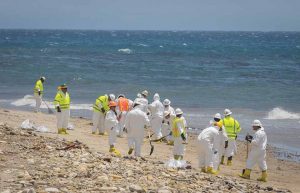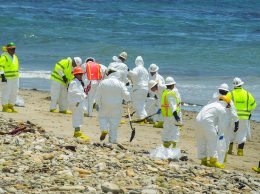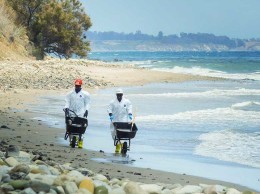Refugio oil spill pipeline might take five years to get back online
IN THIS ARTICLE
- Central Coast Topic
- pacbiztimes Author
By pacbiztimes Thursday, November 5th, 2015
The pipeline that was responsible for the Refugio oil spill in May could take up to five years to get back online and the best-case scenario is 18 to 24 months, according to California Economic Forecast Director Mark Schniepp.
He spoke to a room full of the biggest oil players in Santa Barbara County, public officials and members of the Chumash on Nov. 5 about Santa Maria and the region’s economic future, which are inextricably tied to the oil and gas industry.
If Houston-based Plains All American Pipeline’s Line 901 remains dormant over the next three years, Santa Barbara County could lose out on an estimated $74 million, Schniepp told about 100 people at the Economic Action Summit at the Radisson in Santa Maria.
The county would potentially miss out on about $37 million in property taxes, 155 jobs, $32 million in worker income and $5 million in federal royalties.
“This could probably be expedited and, given the economic impacts I’m about to show you, it ought to be expedited,” Schniepp said about making Line 901 operational. “There are a lot of claimants losing a lot of dollars and will lose them going forward.”
Major oil producers such as Venoco, ExxonMobil and Freeport McMoRan rely on Line 901 and Line 903 to transport their crude. The companies have partially or completely ceased their operations since the pipelines were shut down after the spill and can’t do much more than sit and wait — for now.
The section of the corroded Line 901 was repaired in June, but concerns regarding preventing another rupture have stalled its restart.
Exxon is the region’s biggest oil operator, producing nearly 30,000 barrels per day that generated nearly $1.2 billion in revenue last year. Exxon was on pace to make an estimated $636 million in Santa Barbara County in 2015, Schniepp said, but it has only generated an estimated $216.6 million because production was shut down after the May oil spill. About 65 jobs may be transferred to other Exxon facilities, he said
Santa Barbara County recently rejected Exxon’s emergency application to truck oil to refineries because the company did not prove that an emergency exists, the county said.
“It seems that we should probably do what we can do to get things up and running in order to enjoy the benefits we had prior to the shut down,” Schniepp said. “People are going to feel it.”
Public schools, roads and other public services benefit from the property tax revenues generated from big oil. If the status quo remains, Santa Barbara County public schools would miss out an estimated $24 million over a three-year period, the Santa Barbara County General Fund wouldn’t receive around $8 million and other public services would lose out on about $6.3 million, Schniepp said.
Since the oil spill, public officials have called for more vigilant pipeline regulation, requiring the use of new technology and improving oil spill response. Gov. Jerry Brown signed three bills that require the California Fire Marshal to review oil pipeline conditions every year, not every five years as mandated by more lax federal regulations; aim to make oil spill response faster and more effective; and force intrastate pipelines to use the best-known technology such as automatic shutoff valves. Line 901 is an interstate pipeline.
The Economic Action Summit, coordinated by the Santa Barbara Technology and Industry Association, was sponsored by several of the region’s oil companies and the Santa Ynez Band of Chumash Indians, among others.
• Contact Alex Kacik at [email protected].














